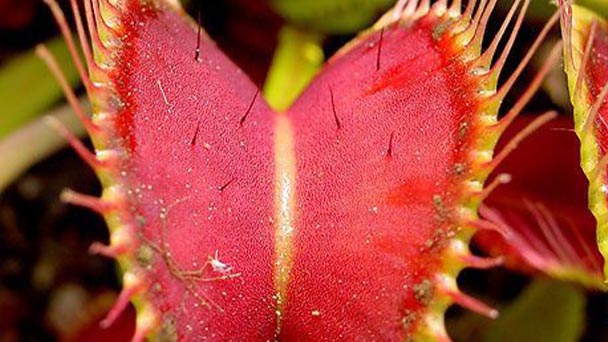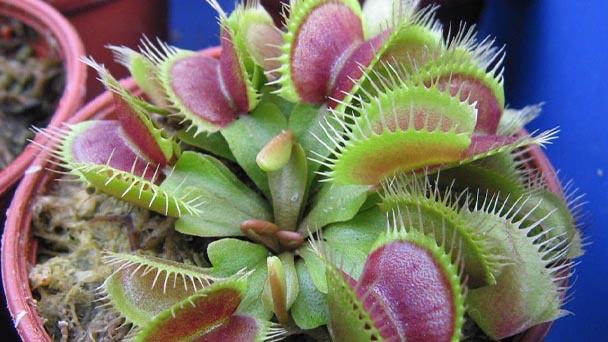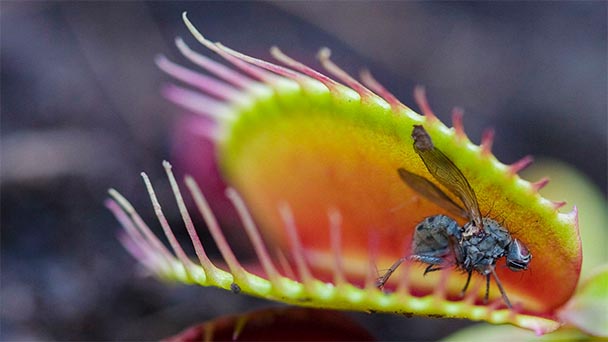Venus Flytrap (Dionaea Muscipula) Profile
Written by Joy
Jan 03 2023

Venus flytrap is an insect-eating plant of the genus Venus Flytrap, which has many small tentacles and three bristles on each side of the leaf. Once the Venus flytrap touches the prey more than three times within 20 seconds, the leaves will close and capture the prey. The Venus flytrap closes quite fast, in less than a second. The geographical range of this distribution is very small, and they exist only in the United States in North Carolina and South Carolina coastal areas. Venus fly traps are simple to grow. The lifespan of a Venus fly trap indoors can reach 20 years with proper care.
Morphological Characteristics
The Venus flytrap is an insectivorous plant that grows on sandy beaches along the North and South Carolina coasts. The flowers grow directly from the roots, while the stalks protrude from the center of the rose-shaped petals. Each leaf consists of two circular lobes connected by the midrib. The outer edge of each lobe is covered with tasselike hairs. Three sensitive filaments grow on the surface of each lobe. As soon as the insect touches the sensitive silk, the lobes snap together, and the hairs on the outer edges will soon lock together, trapping the insect immediately.Varieties of Venus Flytraps
All Venus flytraps are the same species (Dionaea muscipula). In contrast to the wild flytraps, people have created cultivars of that species that have a slightly different appearance. Since most of them have unusual colors, sizes, or mutations, they are usually cultivated. While some mutations are incompatible with life, others are incredibly fascinating. The International Carnivorous Plant Society (ICPS) was designated as the International Cultivar Registration Authority (ICRA) for carnivorous plants, including Venus flytraps, by the International Society for Horticultural Science (ISHS) in 1978. 130 cultivars will be listed by the end of 2021.

Dionaea ‘Justina Davis'
Barry Rice registered this cultivar, which maintains its bright green color even in direct sunlight. On the plant, including inside the trap, there are no other colors.
Dionaea ‘B52'
This Venus flytrap, with traps measuring over 2 inches, was developed by Henning von Schmeling and registered by Barry Rice.
Dionaea ‘Bohemian Garnet'
This plant is half the size of a typical Venus flytrap. Registered by: Miroslav Srba
Growth Habit & Growing Environment
Venus Venus flytrap prefers to live in the swamps, in minerals and other nutrients whose soil is acidic and deficient. Most plants cannot survive in such an environment because they cannot produce enough of the elements necessary to grow. Venus flytraps have evolved the ability to thrive in this unique niche by finding alternative ways to obtain key nutrients. Living things like insects are an excellent source of nutrients that plants lack in the soil. In addition, they contain energy-rich carbohydrates.Although the Venus flytrap has captivated people all over the world, the fact is that the plant lives only in incredibly small geographic areas. In the wild, they exist in an area more than 1,100 kilometers long along the coasts of North and South Carolina. Within this region, the plant's range is further restricted to wet, rainy, sunny marshes and wetlands. Because Venus flytraps are so rare, some early botanists doubted the existence of carnivorous plants, despite widespread stories of them.
The Origin of the Venus Flytrap
The origin of the Venus flytrap may have something to do with its ability to catch insects. According to the International Association of Insectivorous Plants, the origin of the name is sensational. The study of Venus flytrap dated back to the 17th and 18th centuries. The social customs of that time were ascetic compared with those of today, and were deeply troubled by human desires and SINS. Women are often deliberately portrayed as seducers and power-hungry villains. The Venus flytrap can set traps to trap and digest insects. Botanists at the time clearly saw similarities between this skill and certain aspects of female anatomy and behavior. So it’s said that they have named the plants after Venus, the pagan goddess of love and money.
Venus Flytrap Cultivation
Venus flytraps are wild plants that grow naturally. The basic criteria for growing Venus flytraps at home are to simulate the conditions under which they can thrive. This means that they must be grown in an environment that meets the following conditions.Moist
You'd better propagate Venus flytrap in a transparent, lidded container that retains water and keeps the air moist, while letting in plenty of sunlight.Acid
You need to go to a garden supply store to buy a mixture of peat and sand with nutrients similar to those that can be found in swamps. If you overfeed your Venus flytrap in an attempt to make it grow larger, you may end up stunting rather than promoting its growth, because the plant has evolved to thrive in a barren environment.
Caring for Venus Flytrap
Compared to other houseplants, venus flytraps require a little more attention and care. However, you can have a flourishing carnivorous plant once you understand their particular requirements and create the ideal conditions.
Water
Unlike most plants, where it's best to let the soil dry out until the next watering, victorious flytraps love water and must be kept moist at all times. Venus flytraps require regular moisturizing. When 25% of the growing medium has dried out, give them water.
According to Palomares, you will typically need to water every two to four days, depending on the season and where you live.
Despite the fact that this plant needs moist surroundings, you don't want to overwater it. They should never be allowed to sit in water as the roots will rot and the plant will eventually die.
If you usually use tap water for your plants, you'll need to take extra care with Venus flytraps if you want to keep them healthy. Use only distilled or reverse osmosis water because tap water may contain minerals that, over time, could harm the plant.
Sunlight
The more heat and sunlight these plants receive, the better off they will be, and the faster they will grow. Palomares claims that they need between 10 and 12 hours of sunlight per day for optimal growth, with six hours of direct sunlight being the minimum requirement. (Read More: Venus Fly Trap Light Requirements - Does It Need Direct Sunlight?)
Place your Venus flytrap next to a window that gets plenty of sunlight if you're growing it indoors, or use a grow light to help. If you have no other choice, leave the grow light on for 12 to 16 hours every day since they are not as powerful as the real thing. In order for your Venus flytrap to enjoy the summer sun, it is best to move it outside.
Soil
Venus flytraps are picky when it comes to their growing environment. Instead of using roots in the soil like most other plants, these plants have evolved to absorb nutrients from their traps. In what should they be planted then? It is recommended to use perlite, sphagnum moss, or a combination of the two.
Additionally, you don't want to provide any extra nutrients to your Venus flytrap. In fact, you want to do the opposite and avoid any nutrient-rich soil or amendment. Compost, fertilizer, and potting soil should never be used because they will kill your plant.
- Read More: How Big Do Venus Flytrap Get
Winter Dormancy for Venus Flytraps
Venus flytraps, like many other plants, require a period of winter dormancy during which they appear to be dead but are actually just resting (the leaves may die back). Maintain the plant between 35 and 50 °F. Keep terrariums from freezing; doing so could result in plant death and glass breakage. When the days start getting longer in the spring, the warmth and light levels start to rise.
Read More About Venus Flytraps
- Are Venus Fly Traps Animals or Plants - Are They Illegal?
- How Long Can Venus Flytraps Live - Venus Flytrap Life Cycle
- How Does the Venus Flytrap Work?
- How to Repot a Venus Flytrap
- How Much Does Venus Flytrap Cost
- How Does A Venus Flytrap Kills & Eat Insect - RayaGarden
- How Big Do Venus Flytrap Get - Growth Rate & Speed
Latest Updated
- Benefits of Bugleweed - 7 Science-backed Health Benefits
- Bugleweed Dangers & Side Effects - Is It Poisonous?
- How to Plant Evergreen Trees - What You Should Know
- When to Plant Evergreens - Grow Guide for Evergreen Trees
- 12 Wonderful Evergreen Shrubs for Your Garden
- 12 Popular Evergreen Plants with Pictures for Beginners
- When And How To Prune A Lilac Bush Like a Pro
- How to Grow & Care for Lilac Vine (Hardenbergia Violacea)
- Japanese Lilac Tree (Syringa Reticulata) Care & Propagation Guide
- Shumard Oak Pros and Cons - What to Know
Popular Articles
- Winter maintenance of Antirrhinum Majus
- How to Grow Terminalia Mantaly Tree
- How to Grow and Care for Crossostephium Chinense
- How to grow Antirrhinum Majus in spring
- Peristeria Elata (Dove Orchid) Profile: Info & Care Guide
- Underwatered Snake Plant (Sansevieria Trifasciata) - Signs And How To Fix
- How to Care for Brazilian Jasmine Plant (Mandevilla Sanderi)
- How to Grow & Care for Graptopetalum Purple Delight in Summer
- Rosa Chinensis (China Rose): Plant Growing & Care Tips
- How to Care for Baby Sun Rose (Aptenia Cordifolia)